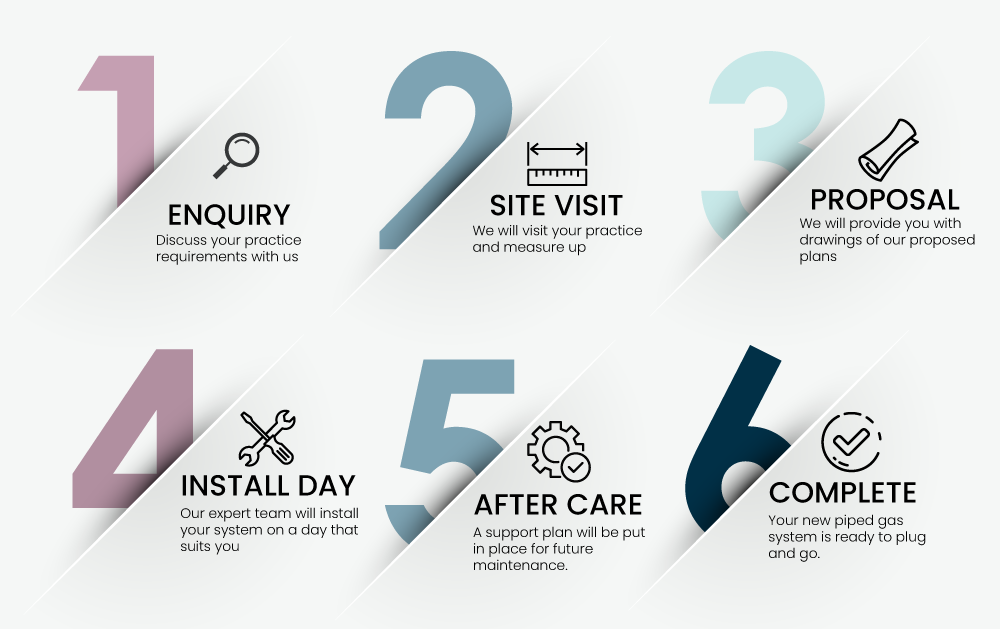
By Joel Huey - Content Editor & Dan Williams - Project Manager
Do you know what to look out for when researching piped gas systems?
There are lots of articles that tell you what materials are used, but not why. So we had a chat with the experts to try and breakdown the lingo and explain the science behind it, helping you to make an informed decision for your practice.
When researching a piped gas system for your practice, the first highlighted benefits you will see from suppliers are:
1. The long-term savings, 2. convenience, and 3. Practicality for staff.
Whilst these are unquestionable benefits of an all-encompassing gas system. The most fundamental feature should always be safety.
Unfortunately, in practice, cylinder storage is a given. They have become part of the furniture. And whilst safety precautions are taught and adhered to, not having them inyour theatre room and having to be manoeuvred around everyday, signifi cantly reduces the risk of something going wrong.
Installing a piped gas system alleviates this concern by removing gas cylinders from inside your practice wherever possible, or at least reducing the amount needed, whilst improving access to those gases. It also means your staff no longer need to manoeuvre heavy cylinders around.
But a piped gas system comes with its own safety considerations and will only make your practice safer if it comes with well-thought-out, built-in, safety features.
As we know, veterinary regulations are not in line with medical standards, yet…
There are 2 commonly used materials for piped gas runs. These are pipeline leads (anti-static flexible hoses) and copper piping. To meet medical standards, copper piping must be used, this is not yet the case in the Veterinary industry.
Piped gas runs are hidden above false ceilings, should the pipe start to wear away, which will eventually happen with flexible hosing, then it is not visible and can cause dangerous leaks that you are unaware of in your practice. This can pose a significant risk to your staff.
Therefore, we use medical-grade copper piping for all Burtons piped gas systems, using strict medical standards as guidance.
"Owing to its reliability and natural antimicrobial resistance, copper is widely considered the gold standard for medical gas piping. It’s why medical construction contractors around the world are now pushing ahead with medical copper pipes" - www.cuspuk.com
So why doesn’t everyone use copper piping?
Copper is often not used due to the installation preparation it takes. It must be thoroughly cleaned and de-greased, removing any oil used in the manufacturing process. Protecting your practice and staff by eradicating the risk of spontaneous oil combustion, and ensuring the safety of your patients receiving the medical gas.
It also takes more designing, due to the infl exible nature of the materials used. At Burtons, we recognise that having the extra safety of copper pipework is worth the extra design time. Our project team will work with you from start to finish, measuring your practice, discussing your requirements and working around your practice needs.
Using our most experienced team to design the system, followed by our experienced install teams to fit the system, and organising routine checks with our service department.
A Burtons piped gas system uses as little anti-static tubing as possible, this is because, as we have already discussed, it will inevitably need changing at some point, so these are only used in your cylinder store to connect to regulators, and for connections to anaesthetic machines. All visible areas that can be routinely checked. These leads also come with date stamps to show you when it needs to be replaced, something that our service engineers will do for you. Each of these leads also comes with a Schrader fi xing, ensuring it cannot accidentally be fixed to the wrong gas.
No two installations are the same
Every piped gas system we fit has completely individual requirements, the size of the building, how many floors it’s over, how many locations the gas needs to run to, how often the system is used, active gas scavenging requirements, and which anaesthesia machines are being used. The list goes on and on, hence why no two systems are ever the same.
We are constantly listening to customer feedback and observing these different installations to find ways we can develop the day-to-day running of procedures. Whether this is for efficiency, cost, or design, safety is always the lead in everything we do.
Want to discuss your practice requirements? Check out our step-by step enquiry guide and call 01622 834300.
Your step-by-step guide to a piped gas enquiry

What else do you need to consider...
Cylinder Store – We can install an external galvenised cylinder store if your practice does not already have an external storage room. As standard, we will install rings and brackets for storing 3 x ‘J’ size cylinders for an oxygen installation. If you require nitrous oxide, we provide 2 x ‘G’ size rings and brackets, and for medical air, a further 2 x ‘J’ size sets.
Gas Controls – Regulators are included with the system to reduce cylinder content pressure to the appropriate working pressure. For oxygen, we include 2 regulators, for all other gases we supply one per gas. Each of these is fitted with a Schrader quick-release valve, in the case of oxygen, this reduces cylinder change over time. The cylinders are connected to the pipeline via an anti-static colour-coded hose, fitted with the relevant Schrader probe.
Outlets – We offer a choice of surface-mounted wall outlets or flexible ceiling pendants. Surfacemounted outlets consist of a smooth white ABS casing similar in appearance to a household electrical fitting. Housed within the casing is a gas-specific quickrelease valve for each medical gas. Outlets are designed to fully meet the requirements of BS EN 737. Gas outlets will accept Schrader gas probes to BS5682:1984 and AGSS outlets, probes to BS6834:1992.
AGSS pump – We will supply a 240v 1-phase AGSS pump. The unit is mounted on wall brackets and secured to a suitable outside wall. A starter with overload is mounted on the pump, and a remote-control panel featuring run and failure indicators will be mounted within the theatre prep room.
Anaesthetic Machines - Your anaesthesia apparatus may require modification or replacement for use with piped gases. We can carry out modifications during the main installation.
Air Breaks – Each anaesthetic machine will additionally require an air break for use with the AGSS. The air break eliminates any induced flow from the patient circuit. It also has a visual flow indicator, an important safety feature since the flow of air is a relatively quiet operation and the pump has mounted some distance from the point of use. Air breaks can be wall mounted near the AGSS outlets if you chose to have wallmounted anaesthetic machines or mounted on the frame of mobile anaesthetic machines.
Low-pressure warning device – This is fixed in line with the oxygen pipeline and will emit an audible warning if the line pressure falls below 30psi. Removes the need to leave the building to isolate the gas supply when it is not in use.


